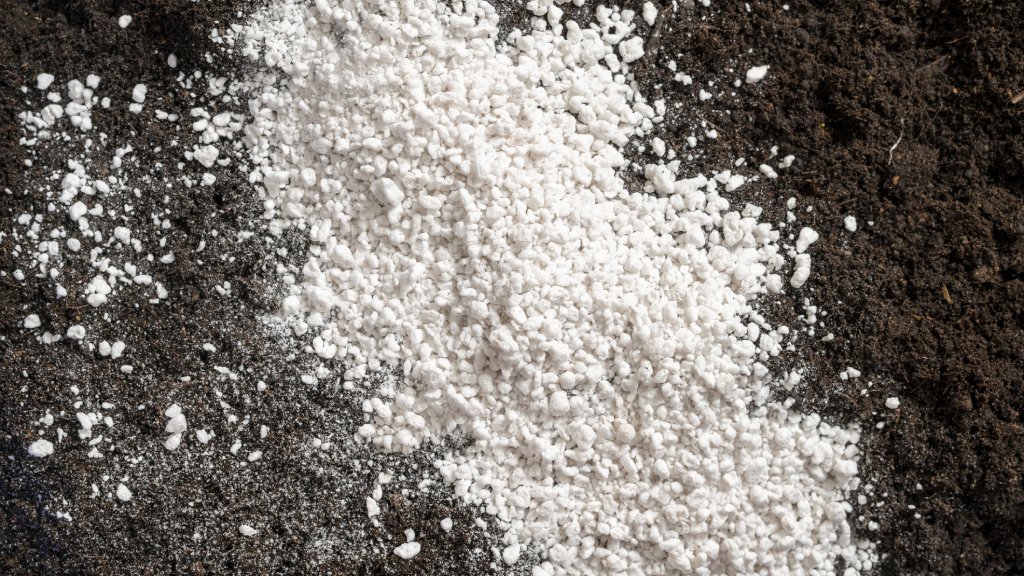How to Use Perlite for Lightweight, Well-Draining Container Gardens

Mary Jane is a writer, engineer, and organic gardener from small-town Canada. She blogs about organic gardening and the garden lifestyle at Home for the Harvest.
Container plants should be planted in a light, well-draining, nutritious soil mix.
Why Not Use Backyard Garden Soil in Container Gardens?
Existing garden soil is not the best choice for container gardens. It can often have too much clay, too little organic material, or other issues such as contamination or weed seeds. Container gardens require a light, well-draining, nutritious growing medium. Rather than using garden soil, use a high-quality potting soil that contains perlite. Perlite will trap air in the soil, ensuring that roots can perform their primary functions. High-quality potting soil often already contains perlite, along with a mix of peat moss with lime, coconut coir, high-quality compost, and sometimes added nutrients (which can be organic or synthetic). Always check the ingredients of potting soil before purchasing it.
Perlite is an expanded volcanic glass that your container plants will love.
What is Perlite?
Perlite is a mined volcanic glass which is "popped" in ovens (like popcorn) to create an expanded lightweight growing medium. Perlite is safe for organic gardening and is listed as an allowed soil amendment by the Organic Materials Review Institute. It's low density makes it perfect for trapping air in soil mixes. Perlite keeps soil light, provides plant roots with air, and promotes drainage. If you've seen store-bought potting soil that contains little white pieces that look like tiny bits of styrofoam, chances are you've seen perlite! Perlite can be dusty, so be sure to wear gloves and a dust mask when working with it. It can also be moistened prior to mixing to keep dust down.
Perlite is a key component of a good container gardening mix.
Using Perlite for Lightweight, Well-Draining Container Gardens
Aeration is very important for healthy plant roots. The cells in plant roots require oxygen from the surrounding soil environment to release the energy needed for healthy growth and nutrient uptake. Overwatering can cause a plant to "drown", because the roots become saturated with water and don't have access to adequate oxygen. Adding perlite to potting mix will trap air into the soil and allow water to drain out. It can be added to custom soil mixes or to pre-mixed potting soil to lighten it up (even if it already contains a bit of perlite already). Ensuring your container soil has enough oxygen will also help the beneficial micro-organisms in the soil thrive, as they also require oxygen. For more information on how to mix your own DIY potting soil using perlite (including printable soil mix recipes) check out this tutorial.
Gardening tips, videos, info and more delivered right to your inbox!
Sign up for the Gardening Know How newsletter today and receive a free copy of our e-book "How to Grow Delicious Tomatoes".
This mint would grow in a shallow container, but was planted in a 2" deep planter to keep it within arm's reach of the kitchen counter!
Beyond Aeration
In addition to trapping air to provide oxygen to plant roots, perlite is also perfect for adding lightweight volume to oversize plant containers. It's always nice to use a suitably-sized pot for the plant, but sometimes an oversize pot is used for decor or accessibility. It can be expensive and heavy to fill up an oversize container with high-quality potting soil, making perlite a desirable option. Even in a large pot, many plants will want to send their roots down as low as possible. Some gardeners fill the bottom of large containers with styrofoam, which is also lightweight but is a petrochemical product. Other gardeners use pebbles or cobbles to fill up the bottom, but that makes for a very heavy container. Instead of using styrofoam or rocks, use perlite in the bottom of the pot to fill the extra volume without adding weight or chemicals to the soil. The perlite can be mixed with a bit of potting soil to keep tall containers from becoming top-heavy, or the perlite can be used by itself as a bottom layer in wide oversize pots. Roots will grow down into the perlite layer whether or not soil is mixed into it.
Perlite was used as an upper layer in this mini cactus container garden. The perlite drains well, looks sharp, and was a cheaper alternative than purchasing decorative sand or pebbles.
Another way that perlite can be used in container gardens is to add a lightweight decorative mulch to the top of an ornamental container plant. Placing fresh perlite on top of the soil around the plant or using it for a lightweight upper layer of growing medium creates a fresh, modern container arrangement.
Perlite is Perfect for Container Gardening
Perlite is the perfect soil amendment to keep your container garden soil light, airy, and full of life. Try a mix that contains perlite or whip up your own custom soil mix! Your container plants will thank you.
-
 Looking For Plants To Give You The Soft And Fuzzies? Try These 5 Fuzzy Leaf Plant Options
Looking For Plants To Give You The Soft And Fuzzies? Try These 5 Fuzzy Leaf Plant OptionsLovers of texture, drama, silver foliage and tactile plants will adore these special sensory garden additions. These fuzzy leaf plant options will leave you all aglow
By Susan Albert
-
 Get Ready For A Summer Of Hummers! Grow These Full Sun Hummingbird Plants and Flowers
Get Ready For A Summer Of Hummers! Grow These Full Sun Hummingbird Plants and FlowersIf you’re lucky enough to enjoy a sunny backyard, make sure you are maxing out on your pollinator opportunities and grow these full sun hummingbird plants and flowers
By Tonya Barnett
